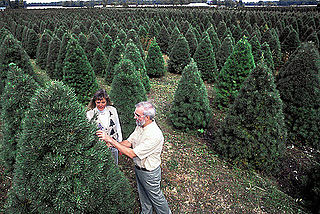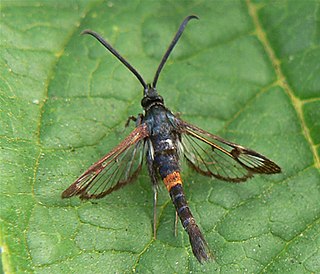
The Curculionidae are a family of weevils, commonly called snout beetles or true weevils. They are one of the largest animal families with 6,800 genera and 83,000 species described worldwide. They are the sister group to the family Brentidae.

A bark beetle is the common name for the subfamily of beetles Scolytinae. Previously, this was considered a distinct family (Scolytidae), but is now understood to be a specialized clade of the "true weevil" family (Curculionidae). Although the term "bark beetle" refers to the fact that many species feed in the inner bark (phloem) layer of trees, the subfamily also has many species with other lifestyles, including some that bore into wood, feed in fruit and seeds, or tunnel into herbaceous plants. Well-known species are members of the type genus Scolytus, namely the European elm bark beetle S. multistriatus and the large elm bark beetle S. scolytus, which like the American elm bark beetle Hylurgopinus rufipes, transmit Dutch elm disease fungi (Ophiostoma). The mountain pine beetle Dendroctonus ponderosae, southern pine beetle Dendroctonus frontalis, and their near relatives are major pests of conifer forests in North America. A similarly aggressive species in Europe is the spruce ips Ips typographus. A tiny bark beetle, the coffee berry borer, Hypothenemus hampei is a major pest on coffee plantations around the world.

The term woodboring beetle encompasses many species and families of beetles whose larval or adult forms eat and destroy wood. In the woodworking industry, larval stages of some are sometimes referred to as woodworms. The three most species-rich families of woodboring beetles are longhorn beetles, bark beetles and weevils, and metallic flat-headed borers. Woodboring is thought to be the ancestral ecology of beetles, and bores made by beetles in fossil wood extend back to the earliest fossil record of beetles in the Early Permian (Asselian), around 295-300 million years ago.

Hylobius is a genus of true weevils. Several Hylobius species are major pests of coniferous trees.

Curculio nucum, the nut weevil, is a medium-sized beetle, with an especially elongated snout, characteristic of the Curculionini tribe of the weevil family (Curculionidae). Its larvae develop in hazel nuts Corylus avellana, being a serious pest in hazelnut orchards. It occurs in most of Europe, from south Sweden, Finland and Great Britain to the Mediterranean.

Pine and fir trees, grown purposely for use as Christmas trees, are vulnerable to a wide variety of pests, weeds and diseases. Many of the conifer species cultivated face infestations and death from such pests as the balsam woolly adelgid and other adelgids. Aphids are another common insect pest. Christmas trees are also vulnerable to fungal pathogens and their resultant illnesses such as root rot, and, in the U.S. state of California, sudden oak death. Douglas-fir trees in particular are vulnerable to infections from plant pathogens such as R. pseudotsugae.
Hylobius warreni, Warren's rootcollar weevil, is a common pest of spruce and pine throughout Canada. It causes considerable damage to native species of spruce both in natural stands and in plantations.

Synanthedon myopaeformis is a moth of the family Sesiidae and the order Lepidoptera. In Europe it is known as the red-belted clearwing and in North America as the apple clearwing moth. The larvae create galleries under the bark of fruit trees, especially old trees with damaged trunks. During this process, the larvae cause significant damage to host trees. Particular attention has been paid to the damage they cause to apple trees. Their status as a pest of apple orchards has led to many research projects aimed at controlling populations of the moth. This moth is native to Europe, the Near East and North Africa. Recently, the moth was introduced into North America, being first detected in Canada in 2005. There are several organisms that threaten the larvae, including parasitoids, nematodes, and bacteria.

Otiorhynchus ovatus, the strawberry root weevil, is one of the many species in the weevil family (Curculionidae), occurring across Canada and the northern United States. The species was first described by Carl Linnaeus in his landmark 1758 10th edition of Systema Naturae. Its name comes from its affinity for strawberry plants, which form a large part of its diet. They are, however, known to feed on other plants as well. Occasionally the larvae cause serious damage to seedlings and young transplants in plantations and nurseries. It is known to be one of the major pests threatening sub-tropical strawberry farming.

Hylobius transversovittatus is a species of weevil in the family Curculionidae. It is native to the Old World where both adults and larvae feed on purple loosestrife. This plant is regarded as an invasive species in North America and the weevil has been introduced into both the United States and Canada in an effort to control the plant.

The sirex woodwasp is a species of horntail, native to Europe, Asia, and northern Africa. Adults vary in length from 9 to 36 mm.

The South American palm weevil, Rhynchophorus palmarum, is a species of snout beetle. The adults are relatively large black beetles of approximately one and a half inch in length, and the larvae may grow to two inches in length.

Hylastes ater is a species of beetle in the family Curculionidae, the true weevils. It is a bark beetle, a member of the subfamily Scolytinae. Its common name is the black pine bark beetle. It is native to Europe and parts of Asia, including China and Korea. It is known as an introduced species in many other regions, including Australia, New Zealand, the Americas, and South Africa. It is a pest of pines and other trees, and it is widespread in areas where pine trees are cultivated. The species "is an important threat to the biosecurity of all forested countries."

Curculio elephas is a species of beetle in the family Curculionidae, the true weevils. It is known commonly as the chestnut weevil. It is a serious pest of chestnut in Europe.

Diprion pini, the common pine sawfly, is a sawfly species in the family Diprionidae. It is a serious pest of economic forestry, capable of defoliating large areas of pine forest. It occurs throughout Europe and Russia.

Acantholyda erythrocephala is a species of sawfly in the family Pamphiliidae commonly known as the red-headed pine sawfly or the pine false webworm. Native to Europe, it has been introduced into North America where it has become invasive.

Curculio sayi, the small or lesser chestnut weevil, is a species of true weevil in the family of beetles known as Curculionidae.

Pissodes nemorensis, known generally as the eastern pine weevil or deodar weevil, is a species of true weevil in the beetle family Curculionidae. It is found in North America and Africa. Deodar weevils are considered a forest pest in the United States, with adults and larvae feeding on a variety of coniferous tree species, including trees such as deodar cedar, loblolly pine, longleaf pine, sand pine, shortleaf pine, slash pine, and spruce pine Trees of all ages are susceptible to weevil infestations, while trees that are severely stressed by fire, drought, extreme cold, fusiform rust, wind damage, and other problems are prone to weevil infestation. In well-managed pine stands, deodar weevil infestations are sporadic, attacking only the suppressed and unhealthy trees throughout the area. Because they do not typically effect healthy trees, they do not usually alter traditional management strategies. Unlike many other forest pests in the eastern United States, deodar weevils are most active in the winter months, and this is often when sign of infestations can be seen. The best way to avoid a deodar weevil infestation is to maintain good tree and stand health: healthy trees do not typically face mortality or extensive damage from these pests. If an infestation has occurred, pesticides can be used in the fall as the weevils become active, but are typically not recommended.
Tariq Butt is an entomologist in the UK, he is Professor of Biosciences at Swansea University in Wales.
Holotrichia disparilis is a species of chafer found in Sri Lanka.



















